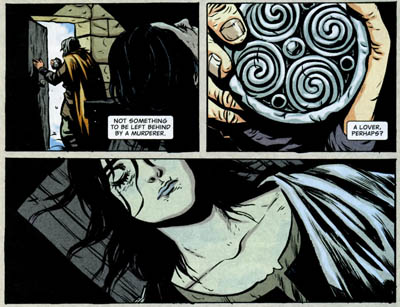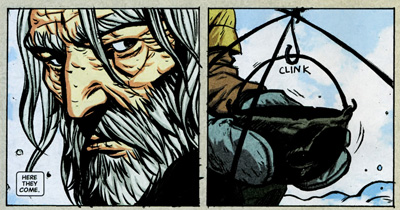 Written by Brian Wood
Written by Brian Wood
Art by Becky Cloonan
32 pages, color
Published by Vertigo/DC Comics
With the temperature well below freezing in the DC area, it’s nice to pull on some blankets, eat a hot bowl of homemade soup, and get down to an afternoon of reading. But ironically, the idea of reading about warm, sunny destinations gets old before long, so it seemed like the perfect time to give the latest Northlanders story, the two-part "The Girl in the Ice," a whirl. If nothing else, it’s a good reminder that while it may be cold in my neck of the woods, it could just as easily be distinctly worse out, and not just because of the advent of modern heating.
 The shorter storylines in Northlanders always feels like a bit of a gamble. Some of them (like "Lindisfarne") have ended up in the realm of favorite stories, while others never quite clicked. With "The Girl in the Ice," it’s a strange story in that it feels like in many ways we’re only scratching the surface of something much larger that we never get to see play out. Set in 1240 Iceland, Jon Jonnsson is living a quiet life until the day he discovers the body of a girl under the ice, preserved by its frigid temperature, but from there it becomes an obsession even as he knows the longer he keeps her above the ice, the greater the chance is that someone will discover her and think that he’d killed her.
The shorter storylines in Northlanders always feels like a bit of a gamble. Some of them (like "Lindisfarne") have ended up in the realm of favorite stories, while others never quite clicked. With "The Girl in the Ice," it’s a strange story in that it feels like in many ways we’re only scratching the surface of something much larger that we never get to see play out. Set in 1240 Iceland, Jon Jonnsson is living a quiet life until the day he discovers the body of a girl under the ice, preserved by its frigid temperature, but from there it becomes an obsession even as he knows the longer he keeps her above the ice, the greater the chance is that someone will discover her and think that he’d killed her.
Once things get moving, though, the book quietly seems to shift focus as we start seeing more of the outside world. As the world around Jon starts to catch up with him, in some ways the story seems to hit its conclusion before we know it, the resolution being told to Jon even as things elsewhere are winding down. It’s an interesting storytelling decision from Brian Wood, in many ways mirroring the real world. Things come to a conclusion but not in an easy or simple manner. There’s no moment where Jon tells his story and everyone rallies around him, no turning point where everything is going to work out. Instead Wood creates an atmosphere where as soon as the ice first cracks, a certain amount of doom and inevitability has escaped along with the body of the dead girl. And so, pieces of the story like the warriors massing end up being in some ways just a part of the setting, a mild catalyst for the rest of the story. It’s not their tale, though, and so Wood lets them fade back into the background, unresolved.
 Fans of Wood’s work with Becky Cloonan on Demo will be happy to see the pair reunite here, this time in full color. Cloonan’s art is expressive as always, but there’s something slightly different in my eyes on how she’s approached the art in Northlanders. I love that Jon’s bearded face sometimes looks more like an ancient engraving than anything else; it evokes that sense of earlier times and places, and helps set the scene even more than her drawings of Iceland’s snow covered landscape, barren and freezing. Her art keeps a tight focus on her characters, showing us a pair of hands, or a wary face so that your eyes focus right on those specific moments. Toward the end of the comic, she also uses the shadow of that part of the story’s setting to her advantage, making it almost as if the faces are sliding out of the darkness, before retreating back out of sight. It’s an attractive looking book, and I’d like to see Cloonan return to Northlanders again.
Fans of Wood’s work with Becky Cloonan on Demo will be happy to see the pair reunite here, this time in full color. Cloonan’s art is expressive as always, but there’s something slightly different in my eyes on how she’s approached the art in Northlanders. I love that Jon’s bearded face sometimes looks more like an ancient engraving than anything else; it evokes that sense of earlier times and places, and helps set the scene even more than her drawings of Iceland’s snow covered landscape, barren and freezing. Her art keeps a tight focus on her characters, showing us a pair of hands, or a wary face so that your eyes focus right on those specific moments. Toward the end of the comic, she also uses the shadow of that part of the story’s setting to her advantage, making it almost as if the faces are sliding out of the darkness, before retreating back out of sight. It’s an attractive looking book, and I’d like to see Cloonan return to Northlanders again.
"The Girl in the Ice" was an interesting comic in part because it doesn’t feel quite like any other Northlanders story. It doesn’t go quite in the direction one would expect, and its conclusion feels almost muted in its low key, downer of an ending. It’s an interesting diversion, but certainly not the sort of road one would want to go down every month. Fortunately, in the case of Northlanders, its ever-changing nature is one of its draws. It’s not one of the strongest stories in the book to date, but as a quiet and small drama it succeeds in its goals with ease.
